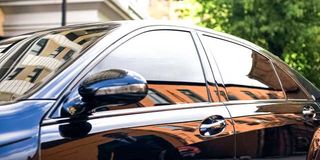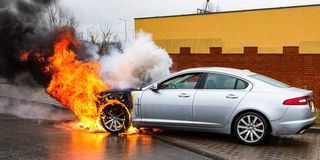Is dark tinting dangerous?

Anything which allows concealment of your presence, or prevents basic evaluation of who you are and what you are doing, or could be dangerous, or even feels threatening to others represents a breach of everyone’s security in a public place.
Hi Gavin, I love your Motoring column in Wednesday’s Daily Nation. Your writing style is at a stratospheric level, and so too is your motoring knowledge. An enjoyable read. Please give us your thoughts on tinted windows in cars. I personally do not fancy darkening windows, despite the persistent request of my wife. One reason is that tinted windows on other cars reduce the vision of what is in front of the car in front of you. And besides, who likes darkened cabins anyway? What is your take on the subject? Charles
Apparently, a lot of people (including your wife) do like darkened cabins. Their reasons do not matter – be they privacy or secrecy or less glare or some more sinister motive – because on public roads the priority is public respect, public safety and public security, not personal preference. Roads are public and essentially interactive places, where the conduct of one person can significantly impact the interests of everybody else.
Any and all personal whimsy must come a very distant second to the wider interest.
The tinted windows subject is heavily loaded with social, technical and security issues, so let’s be very clear about what we are talking about:
The phrase “tinted windows” can mean anything from light tinting (transparent glass that has a slight hint of colouring in it) to dark tinting (where the glass is dyed or laminated heavily enough that it is no longer readily see-through from the outside, and sometimes so dark that it is effective as opaque as black paint). Light tinting is not the problem. Dark tinting is, for a whole raft of reasons:
Technical
Those in favour of all-round dark tinting might argue that while heavy tints look opaque black to onlookers, for those inside the vehicle visibility is not much different from the driver or passengers wearing densely-coloured sunglasses. If there is bright sunlight outside, they have a point. But if external conditions are murky and dull (cloud, heavy rain, fog or that even darker stuff called “nighttime”) people wearing dark glasses can take them off.
Tinted windows are less adaptable, and a heavy tint can seriously compromise visual clarity and acuity – in areas of both central focus and peripheral vision, both of which are important to driver awareness and hence safety.
Proponents of tints will also note that many vehicles (including trucks and panel vans) do not have any windows behind the driver, and others (like camper vans) have curtains, so why should saloon cars and station wagons be full-length see-through?
That logic makes dark tints okay on back windows, so long as you think that setting your standard to the lowest common denominator is an acceptable value system. But that logic also translates to “I can drive more safely than the worst drivers, so I should not have a higher speed limit”.
Also, in no case do the windscreen and the front-door windows have metal panels or curtains on them in any type of public road vehicle. Absolutely clear forward and side vision from the driver’s seat is imperative.
Best practice driving protocol also requires drivers, in more than a few circumstances, to be able to glance back over their shoulder to validate or double-check their rear-view mirror observation. Dark tints on back-door windows or the rear screen obliterate that option. Clearly, (pun coincidental) any tints on windscreens and front door windows should always be fully transparent.
Also, whether purposively or sub-consciously, we all frequently read the body language of the driver of the car we are following as part of our observation and anticipation in traffic, just as we also read the body language of the vehicle itself as a clue to how it might behave and what it might do next.
Social
This is the most emotive issue, where those against dark tints base their case. Hiding in a public place so you can see and recognise and “read” others, but they cannot see, recognise and “read” where you are looking or what you are doing, or perhaps not be able to see you at all - is at best discourteous and at worst, sinister. In these respects, dark-tinted windows are akin to full-face coverings or hoodies, which in some countries in some situations are forbidden by law.
The wearer might be a saint, but once such concealments are allowed they can be too easily used by villains. And that makes everybody uncomfortable. There must be room for different beliefs and tastes: to some people, a car with black-window car looks cool, to others it looks somewhere between inappropriate and downright threatening.
In a public place, the reaction is who are you? What are you doing? Why are you hiding? Legitimate conduct does not need to conceal itself.
Freedom of expression and taste need to have limits and respectful balance. If it is okay to wear a hoodie in a supermarket, then why not a bikini?
The need to recognise and evaluate, and especially eye contact, are not matters of taste – they are fundamental and universal aspects of human nature. My personal take: Even wearing dark glasses while speaking to someone else face to face (though tolerable in some instances) denies those essentials and is therefore disrespectful.
Security
Anything which allows concealment of your presence, or prevents basic evaluation of who you are and what you are doing, or could be dangerous, or even feels threatening to others represents a breach of everyone’s security in a public place. Readers can come to their own conclusion as to which, if any, of those conditions are compromised by dark-tinted car windows.
A problem this owner has never seen before
Dear Gavin, I am ardent reader of your DN2 motoring column. Very informative articles. Kudos. I recently bought a 2008 BMW X5, E70 3.0 diesel. Few months after purchase and very comfortable driving experience its belt tensioner got damaged and the external pulley part fell off. I have never seen this part fall off on other cars. Is this a common problem with BMW X5? What else should I expect in the near future? Is this a reliable car? Thank you. David

Tensioners are the most vulnerable part of a serpentine fan belt’s pulley system, and hence the most likely part of that system to fail on any make of car.
Tensioners are the most vulnerable part of a serpentine fan belt’s pulley system, and hence the most likely part of that system to fail on any make of car. The main pulleys are usually large and in fixed positions – operating the water pump, alternator and power steering, AC and sometimes more.
The tensioner is smaller, lighter and less securely mounted so it can be easily adjusted by screwbolt, spring or hydraulics. Because it is smaller it spins much faster than the other pulleys so its bearings have more potential to overheat, seize, and snap the flimsier mountings.
The most common cause of failure is probably loss or degradation of the bearing grease, allowing corrosion of the bearings, even more heat to damage the bearing chase, and then seize and shear. Checking good lubrication of the tensioner should be a routine service item.
Because the tensioner is essential to all the things the belt operates, it should be the first suspect if any of the functions those pulleys deliver (steering, water pump, power steering, AC) start to behave oddly. Screeching or growing noises should prompt a visual check. In action, the tensioner should not jerk or wobble.
The BMW X5? Enjoy.
Rapid action is vital to stop a car fire
Your article on the flammability of cars gives us all pause for thought. Generally, if a car catches fire for whatever reason, how long has the driver got to take action to stop it becoming a disaster?

The widely accepted reckoning is…30 seconds…from the first smell or sight of smoke to a rapidly spreading blaze. If you can take positive remedial action in that time, in most circumstances, you have a good chance of extinguishing the fire.
The widely accepted reckoning is…30 seconds…from the first smell or sight of smoke to a rapidly spreading blaze. If you can take positive remedial action in that time, in most circumstances, you have a good chance of extinguishing the fire. With every moment of additional delay, those chances are reduced.
Certainly, the sooner you take some action the better, with whatever is to hand. Ideally, a foam or powder fire extinguisher. Failing that, or in addition to it, sand or earth scooped up and thrown onto the problem can be quite effective. If you always carry some extra weight to make the suspension more comfortable (such as in a pick-up) a bag of sand would be a good choice – it will sit still, be quiet, and could be very handy.
Water is not recommended, especially if there is fuel involved. It is more likely to spread the fuel (and the flames) than extinguish them. If the fire really takes hold before you can damp it, the chances of saving most of the car are remote unless you are lucky enough to have half a dozen or more passing motorists stop and bring their own fire extinguishers (or sandbags) to the effort. If the fire has got anywhere near the main fuel tank, change your priority to getting your passengers and any bystanders or helpers and yourself well away.
I say again that the chances of this happening to you are extremely remote, but they are not nil and being in or around a burning car is not a minor matter. That (in addition to the legal requirement) is why you should carry an effective extinguisher, and know exactly where it is in a quick-grab position for your own sake and for anyone else you might be able to help.
The order of business is to stop the car as quickly as you can, kill the engine and pop the bonnet latch. Don’t immediately open it if there are visible flames from within, and take extreme care even if there aren’t any flames (lean back, shield your face and be very ready to drop the lid shut again.)
If the source is oil or fuel, start with whatever extinguishing action is available. If there is clearly an electrical short, try to twist-rip one of the battery cables off its terminal post. Anything you touch might be very hot.
Whatever the circumstances, and whatever the stage of the process, the safety of people is the absolute priority. Standing well back and letting it burn is often a rational strategy.
***
Do you have a motoring question? Email [email protected]





